Arabela House
Houses within 15km of this house
Displaying 90 houses.
Houses within 15km of Arabela House
Displaying 90 houses.
| House name | Description | |
|---|---|---|
| Caherdean House | Charles Daly was leasing Caherdean House from Henry Herbert at the time of Griffith’s Valuation, when it was valued at £11 10s. Bary suggests that the Lawlors may have had connections with Caherdean House around 1800 but later in the 19th century the Herberts were the landlords. The house is still extant and part of a large farm. . |

|
| Knocknamucklagh House | Charles Daly was leasing this property from the Kenmare estate at the time of Griffith’s Valuation, when it was valued at £5 10s. Bary indicates that this is a very old property, possibly built by the Fitzgeralds in the early 18th century when they were Kenmare’s tenants here. By the middle of the 19th century the Daly family were occupying the property which is still extant. | |
| Knockaneacoolteen House | William Curtayne was leasing this house from Lord Kenmare’s estate at the time of Griffith’s Valuation, when it was valued at £4 10s and stood on over 300 acres. Bary indicates that the house, possibly built in the 18th century, is still extant. | |
| Molahiffe House | Eliza Griffin was the lessor of this property at the time of Griffith's Valuation, when it was valued at almost £6 and vacant. In 1837 Lewis mentions "Boucheens" as the residence of Montague Griffin. Bary states that this is a very old house and is widely believed to be one of the earliest homes of the Browne family, later Lords Kenmare. It is still extant and occupied. |
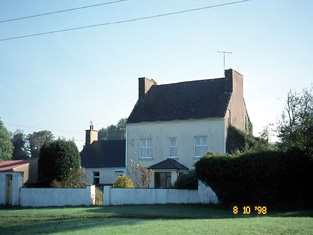
|
| Cloonlara | Christopher Gallway was leasing this property to William Hickson at the time of Griffith's Valuation, when it was valued at £7 5s. A farm is still extant at the site. | |
| Corbally House (Magunihy) | The Kenmare estate was the lessor of Corbally House at the time of Griffith's Valuation, when it was valued at £11 5s. Bary states that this farm was originally held by the O'Connor, probably of nearby Fieries Castle. Later a Fr. Dunne built Corbally House as a presbytery near the old Catholic Church. The property is still extant and occupied. | |
| Inchinveema | Christopher Gallway was leasing this property to Daniel Sullivan at the time of Griffith's Valuation, when it was valued at £6. Buildings are still extant at the site. | |
| Knocknaman | Henry Denny was leasing a property valued at £9 to William Thompson at the time of Griffith’s Valuation. An uunamed house, surrounded by trees, is marked on the 1st edition OS map. There is no house at this site now. | |
| Ballyhar House | In 1786 Wilson refers to Ballyhar, the residence of Mr. Eager. John Leahy was in possession of this property at the time of Griffith's Valuation when it was valued at £17. Bary states that this house was originally built by the Eager family but later sold to the Leahys. It is now a ruin. | |
| Mount St. Annagh | St. John Mason was leasing this property to Johanna O'Connor at the time of Griffith's Valuation, when the house, valued at £3 10s, stood on 800 acres. Johanna O'Connor was one of the principal lessors in the parish of Annagh at that time. The original house is no longer extant. | |
| Caherwisheen | Robert A. Thompson was in possession of this property at the time of Griffith's Valuation, when it was valued at £15. | |
| Ballyard House | At the time of Griffith's Valuation, Francis Crosbie was leasing Ballyard House from Reverend Arthur Rowan, when it was valued at £35. The Colthurst Estate sale notice of 1856 notes that Thompson leased the property from Nicholas Colthurst in the 1820s and that A.B. Rowan was an assignee of Thompson. Bary states that this house was possibly re-modelled by Peter Thompson in the late 1820s. |

|
| Ballyard | The representatives of Peter Foley were leasing a property at Ballyard to Margaret Crosbie at the time of Griffith's Valuation, when it was valued at £30. Lewis records Ballard as the seat of Francis Crosbie in 1837. | |
| Ballyard B | Geoffrey Eager was leasing a property to Patrick Ryan at the time of Griffith's Valuation, when it was valued at £15. | |
| West Villa or West Lodge | Edward Mulchinock was leasing this property from Sir George Colthurst at the time of Griffith's Valuation when it was valued at £15. Bary writes that this is the house associated with William Mulchinock, the writer of the famous song "The Rose of Tralee". It is still extant and occupied. | |
| Cloghane Lodge or Fortlands | At the time of Griffith's Valuation, it was being leased by Francis Fitzgerald to Andrew Shea and was valued at £15. It is still extant. Bary writes that this house was built by the Conway family, possibly in the seventeenth century. It was eventually sold by Nicholas Conway Colthurst to Peter Thompson in the 1820s. The 1856 sale notice records Francis Fitzgerald as the assignee of Peter Thompson. | |
| Cloghers House | In 1786 Wilson refers to Cloghers as the seat of Richard Yielding. John Mulchinock was leasing two adjoining properties from the Colthurst estate at the time of Griffith's Valuation, one valued at £50 and the second at £15. The Irish Tourist Association Survey notes that Cloghers was "once the home of the Mulchinock family who were big landowners" and relates the story of the song "the Rose of Tralee". Bary writes that this property was associated with the Carrigue family in the eighteenth century and also that John Mulchinock was an uncle of William Mulchinock, author of the song. She indicates that it was later owned by the Fitzmaurice family. It is still extant. |
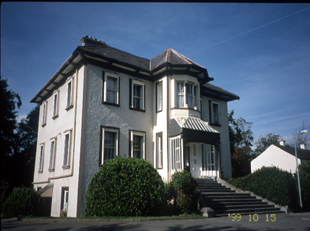
|
| Belmont | Reverend Arthur Rowan was leasing Belmont from Arthur Chute at the time of Griffith's Valuation, when it was valued at £40. Lewis records it as the seat of Reverend A.B. Rowan in 1837. The Ordnance Survey Name Books suggest the house was built by his father in 1826 and cost £1500. However, Bary states that the house, in common with other houses in the vicinity, was built by Peter Thompson in the 1820s, when he was Treasurer of County Kerry. It is still extant and occupied. |
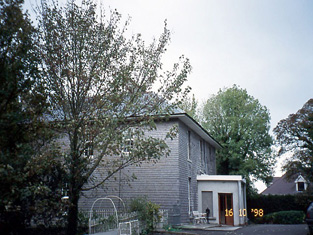
|
| Spring Lodge | Rev. Arthur Rowan was leasing this property to Robert Bell at the time of Griffith's Valuation, when it was valued at £15. Lewis records Spring Lodge as the residence of F.J. Martelli in 1837. Bary states that this is another of the houses built by Peter Thompson in the 1820s. Rowan was married to his daughter Alicia and they lived at nearby Belmont. Spring Lodge is still extant. | |
| Lohercannon House | Catherine Day was leasing this property to Richard Murphy at the time of Griffith's Valuation when it was valued at £15. In 1786 Wilson refers to "Lower-cannon" as "formerly the seat of Rev. Mr. Day, accidentally destroyed by fire". The Ordnance Survey Name Books describe it as the seat of Edward Orpen but originally built by the Day family. Lohercannan is referred to in the Irish Tourist Association Survey of the 1940s as "another building that would be worht a visit".The second house also seems to have been held by the Days but leased out to other families including the Morrises and Eagers. It was demolished to make way for housing in the 1960s. | |
| Ballyroe Lodge | Sir Edward Denny was leasing this property to Pierce Chute at the time of Griffith's Valuation when it was valued at £17 15s. Bary writes that it was built by Pierce Chute, possibly in 1836, according to O'Donovan. The Chutes continued in residence until the late nineteenth century after which it had a succession of owners. It now forms part of the Ballyroe Heights Hotel complex. |
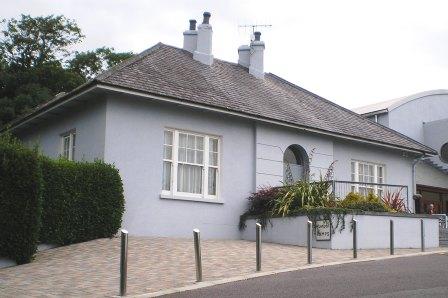
|
| Listrim House | Sir Edward Denny was leasing Listrim House to Robert Fortune at the time of Griffith's Valuation, when it was valued at £12 10s. In the 1830s the Ordnance Survey Name Books record that it was the residence of Henry Oliver by whom it was supposedly erected in 1836. It is now a ruin. | |
| Lisadale Lodge | John Busteed was leasing Lisadale Lodge from William Howard at the time of Griffith's Valuation, when it was valued at £6 10s. The Ordnance Survey Name Books record it as the residence of William Howard, by whom it was supposedly built, in 1836. Bary writes that the house may have been a hunting lodge. It is now ruinous. | |
| Kilmurray House | Anthony Raymond was leasing Kilmurray House to Catherine McIntosh at the time of Griffith's Valuaton, when it was valued at £18 5s. The Ordnance Survey Name Books describe it as " a handsome house, 3 storeys high" in the 1830s. Bary writes Kilmurray was said to have been built by Archibald McIntosh (Cantoss) around 1839 although it appears earlier than that. By 1870, George Raymond, QC, who resided in Dublin, used Kilmurray as a summer home where his relatives, the McIntosh family resided. It is still extant and in 2008, was offered for sale. |
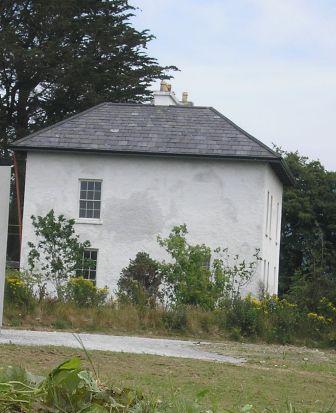
|
| Chute Hall | Richard Chute was occupying Chute Hall at the time of Griffith's Valuation, when it was valued at £37 10s. Lewis also records it as his residence in 1837. The house is named "Tullygarran House" on the 1st edition of the Ordnance Survey map and is so described in the Ordnance Survey Name Books where it is noted it was "three stories high and about a century old". The house later became known as Chute Hall. Bary notes that the Chutes had been resident in this area since the seventeenth century on what had been McElligott land. In 1894 it was the residence of Mrs. Chute. Richard, the last of the Chutes to live here, died in 1936. In 1943 the Irish Tourist Association Survey noted Chute Hall "now almost a wreck but once a fine imposing structure." The house has been demolished but the substantial gateway remains inside which are some fine ogham stones. |

|
| Rathanny House | Elizabeth Rowan was leasing a property to Patrick Holohan at the time of Griffith's Valuation, when it was valued at almost £3. Lewis refers to Rathanny as the residence of Mrs. Rowan in 1837. In the 1830s the Ordnance Survey Name Books noted the house, built c.1730, as the residence of Mrs. Rowan In 1786 Wilson mentions Ratanny as the seat of Mr. Rowan. Bary states that the house was built by the Rowan family in the eighteenth century and lived in by them for much of the early nineteenth century. It was sold in the early twentieth century and is still extant and occupied. |
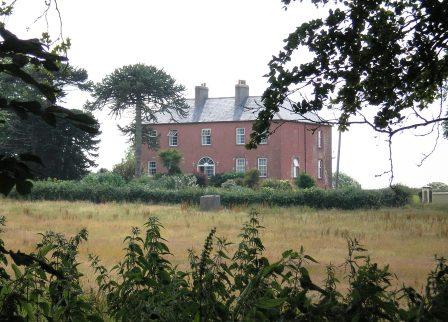
|
| Spring Hill | Richard Chute was leasing Spring Hill to Penelope Chute at the time of Griffith's Valuation, when it was valued at £23. Bary notes that Richard Chute enlarged and extended an existing house here in 1816. Lewis records the house as the seat of Captain Chute in 1837. The Ordnance Survey Name Books note that the original house was thatched but the house existing in the 1830s was "two stories high and neatly built". In the later nineteenth century, the Linden family, agents to the Chutes occupied Spring Hill and remained into the twentieth century. It is now ruined and overgrown. |
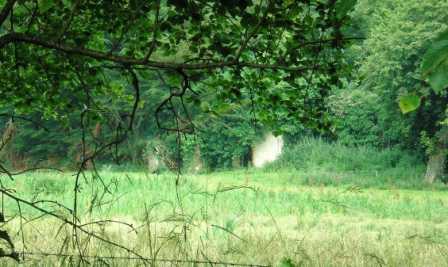
|
| Shanvally | Thomas Blennerhassett was leasing this property to Robert Conway Hurley at the time of Griffith's Valuation, when it was valued at £20. n the 1830s the Ordnance Survey Name Books describe it as the seat of Thomas Blennerhassett, who had built it in 1835. In 1786 Wilson had noted a seat of the Blennerhasset family close to the Rowan house, Ratanny. Bary states that Shanvally was built by the Blennerhassetts as a hunting lodge, possibly in the late eighteenth or early nineteenth century. It is still extant and occupied. | |
| Kilquane | Charles Blennerhassett was leasing this property to Thomas Rooney at the time of Griffith's Valuation, when it was valued at £3, on a farm of 130 acres. This may be the property to which Wilson refers as the seat of William Blennerhasset in 1786 which he names Elm-Grove. A substantial farm is extant at the site. | |
| Knockavinnane Cottage | James Hussey was leasing this property to Alexander Mason at the time of Griffith's Valuation, when it was valued at £15 15s. A portion of the original building is still extant. | |
| Magh House or Edenburn | Colthurst Bateman was leasing a property to Edward F. Day at the time of Griffith's Valuation, when it was valued at £28 15s. On the 1st edition Ordnance Survey map it is labelled as Magh House but on the 1895 edition it is called Edenburn House. Lewis records it as the seat of W. Seely in 1837.The Ordnance Survey Name Books of the 1839s noted that this was the residence of the Sealy family and had been preceded by Rockfield House, the ruins of which were still discernable. Magh is described as "handsomely built of square form, three stories high and cost £2000". Later in the nineteenth century it was occupied by Edward Fitzgerald Day and then by Samuel Murray Hussey, agent to the Kenmare and other estates. In 1906 it was owned by John Hussey and valued at £24. It was used in the later twentieth century by the Southern Health Board as a hospital/nursing home and is still extant. | |
| Maglass House | William Ledmond was leasing Maglass House to Daniel Hilliard at the time of Griffith's Valuation when it was valued at £11 15s. Lewis records Maglass as the seat of W. Ledmond in 1837. The Ordnance Survey Name Books record it as the residence of Daniel Hilliard but originally built by the Ledmond family. Bary, however, states that it was possibly built ty the Babington family who lived there in the eighteenth century. In 1786 Wilson refers to "Maglass" as the seat of Wiliam Sealy. It was later occupied by the Ledmonds who later sold it to the Roche family. Redmond Roche is recorded as residing there in the 1870s. In 1906 it was owned by the representatives of Redmond Roche and valued at £18 5s. It is now derelict and ruinous. |
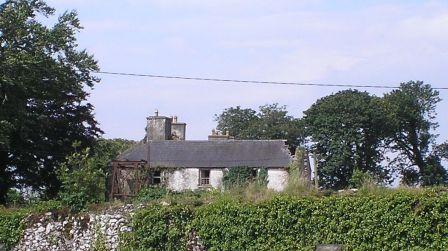
|
| Ashgrove Mill | John Busteed and Arthur Rowan were the lessors of a house and mill at Tonreagh, vacant at the time of Griffith's Valuation, when the complex was valued at £25 15s. | |
| Lassinah | John Day Stokes was leasing this property from Sir Edward Denny at the time of Griffith's Valuation, when it was valued at £20 10s. Bary states that Major Stokes retired here from his Indian Army post and renovated the house where he lived until 1862. It remained in the Stokes family until the end of the nineteenth century and was recorded by Slater as the seat of Maj. Oliver R. Stokes in 1894. It is still extant but ruined. | |
| Kent Lodge | Richard O'Connell was leasing this property from the Denny estate at the time of Griffith's Valuation, when it was valued at £10 10s. Bary states that this house was attached to an earlier building known as O'Connell's Cottage where Rickard O'Connell lived but that Kent Lodge was built by William Collis. The house, which is still extant, remained in the Collis family until the early twentieth century. |
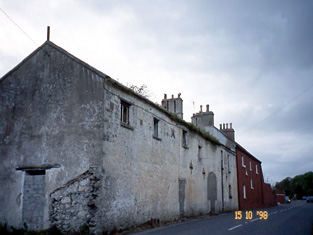
|
| Ballycarty House | At the time of Griffith's Valuation, Charles Blennerhassett was leasing this property to Rev. Edward Nash, when it was valued at £19 5s. Bary states that it was occupied by the Nash family from the late eighteenth century and that it was destroyed in 1922. In 1786 Wilson notes the existence of the ruins of Ballycarty Castle, the property of Mr. Nash. | |
| Ballyseedy Castle | Ballyseedy was a seat of the Blennerhassett family for many generations. Charles Blennerhassett was occupying it at the time of Griffith's Valuation when it was valued at £60. Lewis recorded that Sir Edward Denny was living there in 1837 but that it was a seat of the Blennerhassett family. In 1906 it was owned by Arthur Blennerhassett and valued at £65. The National Inventory of Architectural Heritage (Buildings of Ireland) report states that the house was built c.1760 but renovated and extended at least twice in the nineteenth century. The Irish Tourist Association survey in 1942 reported that the owner then was Miss Hilda Blennerhassett. It remained in the ownership of the Blennerhassett family until later in the twentieth century when it was sold and became Ballyseedy Castle Hotel. [www.ballyseedecastle.com]. |

|
| Ballymacadam House | Robert M. Leeson was leasing this property to John Roche at the time of Griffith's Valuation, when it was valued at £13. In the 1830s, the Ordnance Survey Field Name Books record Lady Franks as the owner of the townland and John Roche occupying the house. In 1786 Wilson refers to Ballymacadam as a seat of the Earl of Glandore. Bary states that the house had a number of owners since its construction in the eighteenth century. It is still extant and occupied. |
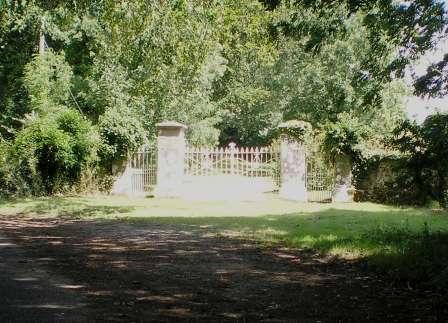
|
| Crag House or Rockville | Robert Leeson was occupying this property at the time of Griffith's Valuation when the lessor was William Miles. It was then valued at £18 15s. On the 1st edition Ordnance Survey map the house is labelled as Rockville. Bary quotes O'Donovan who claimed the owner in the 1830s was John Marshell Myles. The house is still extant and the well-known Crag Cave complex is located in the demesne. See www.cragcave.com | |
| Castleview House | At the time of Griffith's Valuation, Robert Leeson was leasing this property to Edward Hartnett when it was valued at £11. On the 1st edition Ordnance Survey map it is labelled as Charter School but by the 1893 edition it is named as Castleview House. Bary indicates that the property was originally built in the mid-eighteenth century and operated as a Charter School until the 1820s. Papers relating to its operation as a charter school are included in Ms.17,973 [Quane Papers] in the National Library of Ireland. It was later enlarged by the Hartnett family who occupied it for much of the nineteenth century. It is still extant and occupied. |
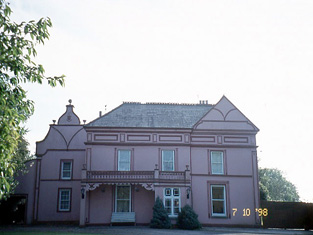
|
| Tobermaing House | Robert Chambers was leasing a property which included a mill to James Chambers at the time of Griffith's Valuation, when it was valued at £26 15s. In the 1830s the Ordnance Survey Field Name Books record Lady Franks as the proprietor of this townland and William Bailey as resident in the house. Bary states that the mill was run by the Bailey family and that the property was later owned by the Roche family. In the 1990s it had been converted into a bar and restaurant. | |
| Camp Lodge | At the time of Griffith's Valuation, Richard Chute was leasing this property to George Hewson, when it was valued at £5 10s and part of a farm of 350 acres. In the 1830s, the Ordnance Survey Name Books describe it as "a small cottage, one story high, the residence of John Hussey". It was offered for sale in the Land Judges' Court in 1883 when it was described as a "comfortable dwelling house, suitable for a gentleman's family". Bary indicates that it had been the home of the Twiss family earlier in the nineteenth century. It is still extant. | |
| Mullaghmarky House | Richard Chute was leasing this property to John Sealy at the time of Griffith's Valuation, when it was valued at £10 10s. In the 1830s, the Ordnance Survey Name Books describe it as " a large house, two stories high, with offices, plantation and ornamental garden, the residence of Eusebius Sealy". Bary states that the Sealys had occupied it since the early part of the nineteenth century. It is still extant though not occupied. | |
| Meanus House | Sir David Roche was leasing the property at Meanus to Michael Neligan at the time of Griffith's Valuation, when it was valued at £9 10s. In the 1830s, the Ordnance Survey Field Name Books describe it as "a large house, two stories high with offices attached at present occupied by a farmer". In 1786 Wilson had noted Menus as the seat of Dr. Drew. Bary states that it has been in the Neligan family for many generations and is still extant. | |
| Tullig House | Henry Herbert was leasing this property to William England Young at the time of Griffith's Valuation, when it was valued at £7. In the 1830s, the Ordnance Survey Name Books describe Tullig as "a large house, two stories high, with offices and a garden, the residence of Widow Chute". Earlier, in 1786, Wilson notes Tullig as the seat of Mr. Sandes. Bary states that the house was originally built by the Saunders family and that it later passed to the Brosnan family who have lived here for several generations. Bary also mentions that William E. Young was married to Agnes Sealy and lived at Ballinvariscal House in Novahal parish. | |
| Plover Hill House | Sir Edward Denny was leasing this property to George Gunn at the time of Griffith's Valuaton, when it was valued at £16 5s. Lewis records it as the seat of George Gun in 1837. Bary states that the house was built in the early nineteenth century by Barry-William Gun, whose mother was Arabella Denny. The Gunn family continued to own the property until the 1880s. Buildings still exist at the site. | |
| Frogmore | John McCartie or McCarthy was leasing this property from Sir Edward Denny at the time of Griffith's Valuation, when it was valued at £16. Lewis records Frogmore Lodge as the seat of Reverend Barry Denny in 1837.The Ordnance Survey Name Books reported that it was built by him in 1828 at a cost of £600 and was lived in, in 1840, by Mrs. Townsend Gunn. It is still extant. | |
| Curragh | William John Neligan was leasing this property from the Denny estate at the time of Griffith's Valuation, when it was valued at £8 10s. Bary indicates that the house has always been occupied by merchant families from Tralee. It is still extant. | |
| Riverville (Currans) | Charles Blennerhassett held this property in fee at the time of Griffith's Valuation, when it was valued at £9 15s. Lewis records Riverville as the seat of Richard Marshall in 1837. The Ordnance Survey Field Name Books record Riverville as the residence of Richard Marshall c.1840, describing it as "a thatched house of oblong shape". Bary states that the house was a seat of the Marshell family and believed to have been built by them in the eighteenth century. They remained there until the 1840s. Later in the nineteenth century it was associated with the Spring family It is still extant and occupied. | |
| Sandville House | Robert A. Thompson was leasing this property from the Herbert estate at the time of Griffith's Valuation, when it was valued at £11 5s. Bary notes that it had been frequently occupied by agents to the Herbert estate through the nineteenth century. It is believed to have been built by them in the late seventeenth century. The house is still extant and occupied. | |
| Clashganniv House | John Powell was leasing this property from the Herbert estate at the time of Griffithf's Valuation, when it was valued at £10. Let also notes it as his residence in 1814 though he refers to it as Sandville. Bary states that the Powells continued in residence until the early twentieth century. Clashganniv is still extant and occupied. |

|
| Dicksgrove | Richard Meredith was the owner of this property at the time of Griffith's Valuation, when it was valued at £30 15s. In 1786 Wilson notes Dick's Grove as the seat of Mr. Meredith. Both Leet in 1814, and Lewis, in 1837, refer to it as the seat of the Meredith family. In 1906 it was still owned by the Merediths and valued at £31 5s. Bary writes that this land, granted to the Herberts in the seventeenth century, passed to the Merediths through marriage some time later. The house was built sometime in the 1730s and remained in the Meredith family for 200 years, though Lyons notes that it was offered for sale but later withdrawn in 1855. The sale notice includes a lithograph of the house The estate was sold to the tenants in the 1930s. Dicksgrove was completely demolished but some of the stable buildings and gate lodges remain. |
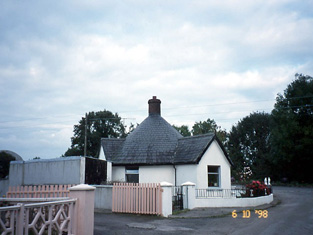
|
| Kilcow House | Robert A. Thompson was leasing Kilcow House from the Herbert estate at the time of Griffith's Valuation, when it was valued at £17 10s. Bary notes that the Herbert family lived here for a time in the eighteenth century before moving to Muckross. The house is still extant and occupied. | |
| Abbeylands or The Abbey | Abraham Huggard was leasing this property from Sir William Godfrey at the time of Griffith's Valuation when it was valued at £5 10s. Local sources suggest it was built by the Huggard family in the early nineteenth century. It is still extant and occupied. | |
| Kilcolman Abbey | Kilcoleman Abbey was the residence of Sir William Godfrey at the time of Griffith's Valuation, when it was valued at £33. Lewis also records it as his residence in 1837. In 1894 Slater referred to it as the seat of Sir John F. Godfrey. In 1906, it was still part of the Godfrey estate and valued at £35 10s.The Irish Tourist Association survey of the early 1940s refers to it as "Godfrey House, a fine type of Elizabethan type mansion". Bary states that the original house, built by the first Godfrey to settle in the area at the end of the seventeenth century, was called Bushfield but that it burned down in 1774 though Wilson still refers to it by this name in 1786 and provides a detailed description of the surroundings. Knightly indicates that a new house was then built by Sir William Godfrey. This house was remodelled twice in the nineteenth century. Sir William Maurice Godfrey sold Kilcoleman in the 1960s and it was demolished in 1977. |
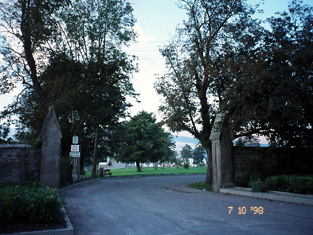
|
| Rathpoge | At the time of Griffith's Valuation, Sir William Godfrey was leasing this property to William Hickson. No house is marked in this area on the Ordnance Survey map, the only buildings being the Kilcolman farmyard. The buildings on the site were valued at £13. It was still in the possession of the Godfrey estate in 1906 with the same valuation but are no longer extant. | |
| Glen Ellen (Kilcolman) | James Godfrey was leasing this property from Lord Monteagle's estate at the time of Griffith's Valuation, when it was valued at £11 10s. Bary indicates that it was in the possession of a branch of the Godfrey family up until the end of the nineteenth century when it was then sold to the Huggard family. Slater notes it as the residence of Jn. T. Huggard in 1894. It has had several owners since then but is still extant and occupied. | |
| Keel House | Edward Rae was in possession of Keel House at the time of Griffith's Valuation. Lewis records it as the seat of Giles Rae in 1837. Bary states this was originally a Langford House, possibly built as far back as the 1680s but with later modificiations. Wilson refers to it as the seat of Mr. Langford in 1786. It passed by marriage to the Rae family with whom it remained until the twentieth century. It was sold but later re-purchased by the family and is still extant. |

|
| Annamore House | Maunsell Andrews was leasing this property to Margaret Roche at the time of Griffith's Valuation, when it was valued at £5 5s, on a holding of 170 acres. Barry quotes O'Donovan, who claims the house was built by the Meredith family in the early eighteenth century. It may also have been associated with Lord Northcote's estate. The Roche family occupied the property since the 1840s. | |
| Killeentierna Glebe | Rev. Thomas Herbert owned the Glebe house at Killeentierna at the time of Griffith's Valuation, when it was valued at £18. Bary states that the house was built by Rev. Herbert in 1839 and was later occupied by Arthur Herbert, a land agent, who was assassinated nearby in the 1880s. The house was later used as a Church of Ireland rectory and later still as a presbytery by the local Catholic parish but has since been demolished. | |
| Parkmore House | Rev. C.Moynahan was leasing this property to Arthur Sealy at the time of Griffith's Valuation, when it was valued at £19 5s. Bary quotes O'Donovan who said it was a set of the Meredith family in the 1830s though she also mentions that it was said to have been built by a Fr. Minahan. It was occupied by members of the Meredith family and later by their descendents and is still extant. Richard Meredith was leasing a second property in this townland to Rev. C. Moynahan which was valued at £5 5s. | |
| Anna | Sir William Godfrey was leasing this property to Cornelius Murphy at the time of Griffith's Valuation when it was valued at £10 5s. Lewis records it as the residence of Reverend O'Connor, PP, in 1837. In 1814 Leet mentions Annagh as the seat of Giles Rae. Bary writes that it was built by the Godfreys in the eighteenth century and was lived in by various members of that family until the early nineteenth century when it was occupied by tenants. It was tragically burnt to the ground in the late twentieth century. Sir William was leasing a second property in this townland to Willam R. Burke, valued at £8 10s. | |
| Laharan House | Sir William Godfrey was leasing this property to James O'Neill at the time of Griffith's Valuation, when it was valued at £7 5s, and part of a holding of 170 acres. It was recorded as the seat of F. Walker by Lewis in 1837 and Leet in 1814 as the seat of Francis Walker. Bary states that it was built by Francis Walker in 1808. The house passed to the Cronin family in the 1880s. It is stil extant and occupied. | |
| Cloonalassan House | Lord Monteagle was leasing this property to John Giles at the time of Griffith's Valuation, when it was valued at £8 5s, on a demesne of 123 acres, some of which extended into Ballycrispin townland. Lewis mentions, in 1837, that Ballycrispin was formerly the residence of the Spring-Rice ancestors. It is not shown on the later 25-inch Ordnance Survey map of the 1890s. | |
| Meanus House (Kiltallagh) | Lady Anne Headley's estate was leasing this property to Charlotte Walker at the time of Griffith's Valuation, when it was valued at £9 15s. Bary writes that it was leased by the Winn estate in the early part of the nineteenth century to the Walkers and later to the Spring family. It is still extant and was renovated in the twentieth century. |
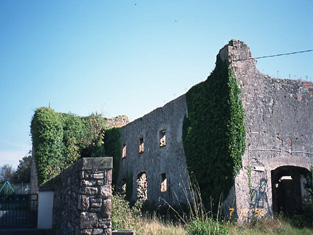
|
| Kiltallagh Glebe | Rev. Brownrigg (or possibly Browning) Drew was in possession of Kiltallagh Glebe at the time of Griffith's Valuation, when it was valued at £17. Lewis records it as the seat of Rev.J. Murphy in 1837. In 1786 Wilson refers to "Menus"as the house of Dr. Drew but he also refers to a residence of Rev. Dr. Day, near Kiltalla church. Bary mentions that it was renovated by Rev. Murphy earlier in the nineteenth century. It was also associated with the Day and Godfrey families. In 1920 it was sold to the Boyle family by the Representative Church Body and is still extant and occupied. | |
| Ballinvariscal House or Mount Prospect | William Massey was leasing this property from TCD Estates at the time of Griffith's Valuation, when it was valued at £5 15s and part of a holding of over 400 acres. In 1814 it was the residence of Roger Lombard. Bary indicates that the house had several different owners in the nineteenth century when it was known as Mount Prospect. It was sold around 1900 and is still extant and occupied. | |
| Woodville (Nohaval) | Richard Norris was leasing this property to Rev. John Fitzgerald Day at the time of Griffith's Valuation, when it was valued at £27. Lewis mentions Nohaval House, as the seat of Rev, Fitzgerald, which seems to be the same property. Bary quotes O'Donovan who indicated that this house belonged to the Norris family. She indicates that the house later passed to Fitzgerald-Lombards and Hicksons. It was sold in the early twentieth century and is still extant and occupied. | |
| Ballyegan | At the time of Griffith's Valuation, Richard Norris was leasing this property to John Millward (senior), when it was valued at £6. In 1814 Leet noted John Hartnett as resident at Ballyegan. Bary indicates that the Millwards occupied this property until well into the twentieth century though they moved to a different house. The original house was demolished to make way for a quarry. | |
| O'Brennan House | John Keane was leasing this property from Lord Ventry's estate at the time of Griffith's Valuation, when it was valued at £5 10s. Lewis records O'Brennan House as the seat of Edward Gorham in 1837. It is still extant. | |
| Glenduff House | Robert Conway Hurley was leaing this property to John Hurley at the time of Griffith's Valuation, when it was valued at £5 15s. In 1906 it was the property of John C. Hurley and valued at £10 15s. Bary writes that the Hurley family owned Bridge House in Tralee but also retained Glenduff House as their country estate. The house remained in the Hurley family until it was sold in the early twentieth century. It has been extensively renovated and is now a guesthouse. |
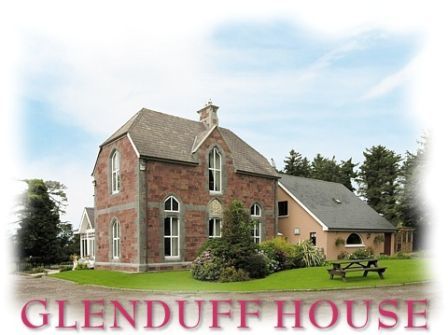
|
| Parkearagh | John Keane was leasing this property from Lord Ventry's estate at the time of Griffith's Valuation, when it was valued at £6. A substantial farm is extant at the site now. | |
| Doon House | At the time of Griffith's Valuation, William M. Hickson was in possession of this property, then valued at £9 15s. | |
| Oakpark or Collis-Sandes House | Maurice Sandes was in possession of this property at the time of Griffith's Valuation, when it was valued at £60. It is labelled as Oakpark on the 1st edition Ordnance Survey Map. In 1837 Lewis recorded Oakpark as the seat of John Bateman. Bary writes that, Killeen, the original house at this site, was a late seventeenth century house. It was followed by Oakpark, built by John Bateman in the 1820s. This is the house mentioned by Wilson in 1786 as the seat of Rowland Bateman. Maurice Sandes purchased the estate in the late 1840s and built the later Oakpark House c.1857. In 1906 this house was owned by Falkiner Sandes and valued at £112. The house was sold in 1922 and is now used as offices. |
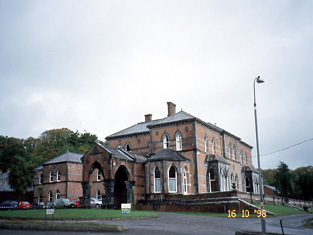
|
| Ballinorig House | At the time of Griffith's Valuation, Colthurst Bateman was leasing this property to Jonathon Walpole when it was valued at £14. The building is not labelled on the Ordnance Survey maps though a more substantial house exists at the site on the later 25-inch edition. Burke records that Colthurst Bateman resided in, and was, High Sheriff of Monmouth, in 1839. Ballinorig House is still extant. | |
| Ann's Villa [Oak Villa] | Thomas Payne was leasing this property from Sir Edward Denny's estate at the time of Griffith's Valuation, when it was valued at £30. The house is labelled Ann's Villa on the 1st edition Ordnance Survey map. A more substantial building, known as Oak Villa, appears on the 25-inch edition of the 1890s. Buildings are still extant at the site. | |
| Lee Brook | Francis Raymond was leasing this property to Richard Roland Chute at the time of Griffith's Valuation when it was valued at £30. In 1906 it was owned by Rowland Chute and valued at £30. Bary states that this house was associated with the Chute family and may have been built by them in the eighteenth century. It remained in the family until the 1930s and is still extant and occupied. The 25-inch edition Ordnance Survey map indicates an additional house in the townland, labelled Lee Brook House. A much enlarged version of this building now serves as Ballygarry House Hotel [Q866134]. | |
| Lismore | Edward Day Stokes was in possession of the house at Lismore at the time of Griffith's Valuation, when it was valued at £13 10s. Bary writes that the house was associated with the Martelli family who were related by marriage to the Blennerhassetts. Later it was occupied by Collis and Huggard families. It is now a ruin. | |
| Tubrid House | George Gunn was leasing this property to Henry Hilliard at the time of Griffith's Valuation, when it was valued at £22 10s. Lewis recorded Tubrid as the seat of J. O'Connell.The Ordnance Survey Name Books indicate that this townland was owned by John O'Connell of Grenagh, Killarney and that John Sullivan of Tubrid was his agent in the 1830s. The house was occupied by Capt. Henry Hilliard at that time. In 1814, Leet noted the house as the seat of Townsend Gunn. Bary states that Tubrid House was built by the Crosbie family in the mid-eighteenth century and resided in by several generations of that family. The late eighteenth century owner, John G. Crosbie, was involved in a duel in which Sir Barry Denny was killed. A year later Crosbie himself died in mysterious circumstances. The house afterwards was owned by the Gunn and Hewson families. It is no longer extant. | |
| Crotta House | Samuel Julian was in possession of this property at the time of Griffith's Valuation, when it was valued at £27. Lewis records it as the seat of T. Ponsonby in 1837 while Leet notes it as the residence of James O'Donnel in 1814. In 1786 Wilson writes that "Crotto" was the seat of James Carrigue Ponsonby and "very pleasantly situated with good plantations". Bary writes that Crotta had been built by the Ponsonby family and was later held on lease from the Court of Chancery by the Julian estate. At the sale of the latter estate in 1857, Crotta was described as being in the hands of the proprietor Samuel Julian. Later in the nineteenth century it was leased to the Kitchener family. Herbert Kitchener, later Earl of Khartoum, lived there as a boy. The estate was the property of the Browne family in the later nineteenth century but was offered for sale by Thomas Beale Browne in 1877. In 1894 Slater records it as the seat of Richard Savage. In the 1940s the Irish Tourist Association Survey describes it as " a ruined shell" where there was once "an imposing mansion". The remains of the house were demolished in the later twentieth century. |
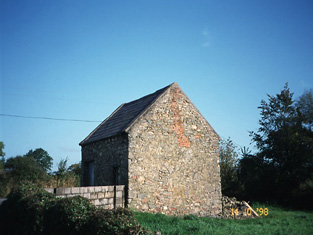
|
| Rea | William Talbot Crosbie's estate owned this property at the time of Griffith's Valuation, when it was valued at £5 15s. The original house is not extant now. | |
| Rockfield | In 1837 Lewis noted that "Rockville" was the property of the representatives of the late John Drew. At the time of Griffith's Valuation, William Whorland was leasing a property valued at £5 10s from the Drew estate. The property was offered for sale by Alicia Wherland in the Landed Estates Court in July 1862 and again in July 1872. In 1906 Rockfield was owned by Bertram Morrogh Bernard and was valued at £11. Bary mentions it as a house associated with the Sealy family. Buildings are still extant at the site. | |
| Oyster Hall | Edward Denny was leasing this property to William J. Neligan at the time of Griffith's Valuation, when it was valued at £18 Lewis refers to it as the seat of Barry Collins while Oyster Lodge was the residence of Mr.Neligan in 1837. IIn the 1830s, the Ordnance Survey Field Name Books mention Oyster Hall as the seat of Daniel Supple but originally built by George Rowan in 1804. In 1814, Leet refers to Oyster Hall as the residence of George Rowan. Bary states that Oyster Hall was orginally built by the Rowans but was associated with the Neligans by the middle of the nineteenth century. It is no longer extant. | |
| Mount Hawk | In 1906 Mounthawk was owned by Elizabeth Stokes and valued at £18 5s. The townland was in the possession of George Stokes at the time of Griffith's Valuation. Bary states that it was built by George Stokes on lands purchased from the McCarthy family and remained in the Stokes family well into the twentieth century. It was later used as a clubhouse by Tralee Golf Club. | |
| Tralee | At the time of Griffith's Valuation, Francis Crumpe was leasing a property, valued at £31, at Denny St., Tralee, from John Donovan. [Grid Reference is approximate]. | |
| Ash Hill House | The Ordnance Survey Name Books record Ash Hill House, parish of Ballymacelligott, as being a ruin, c.15ft high in the 1830s. It had been built by the Blennerhassetts around 1700 and was later occupied by the Eager family. In 1786 Wilson records Ash-Hill as the seat of Thomas Blennerhasset. | |
| Currans House | The Ordnance Survey Name Books record Currans House as in a "decayed condition" in 1840. It was allegedly built c.1700. Francis Peet had resided there until c.1829. At the time of Griffith's Valuation, it was in the possession of Charles Daly, unoccupied and valued at £3. It is labelled Currans House on both the 1st and 25-inch edition Ordnance Survey maps. A house is still extant at the site. | |
| Tralee Castle | In 1786 Wilson writes "at Tralee is a castle in tolerable preservation, formerly one of the castles of the Earls of Desmond, granted by Queen Elizabeth to Sir Anthony Denny, and now the seat of his descendent, Sir Barry Denny". In 1943 the Irish Tourist Association Survey mentions that the last reconstruction of the building occurred in 1802. Bary writes that, after the Act of Union, the Denny family spent more time in England and the castle fell out of use and was eventually demolished and the stones used for other buildings. | |
| Roxborough (Molahiffe) | Wilson, writing in 1786, refers to Roxborough as the seat of Francis Chute. At the time of Griffith's Valuation, the townland was part of the estate of Reverend George Chute and Roxborough House was occupied by a Mrs Kenny and valued at almost £7. It is still extant and used as a farmhouse. | |
| Molahiffe Castle | At the time of Griffith's Valuation, Maurice de Coursey was leasing a property in the townland of Castlefarm from the Kenmare estate which had a valuation of almost £6. It is likely to have been the house labelled on both the 1st and later 25-inch edition Ordnance Survey Maps as Molahiffe Castle. The National Inventory of Architectural Heritage states that this house was built in the mid-eighteenth century. In 1943 the Irish Tourist Association Survey highlights the close links between Molahiffe and the Browne family, who, it says, resided in the area until the building of the first Killarney House. The remains of the original Molahiffe castle are located a short distance from the present house, now known as Castlefarm House. |
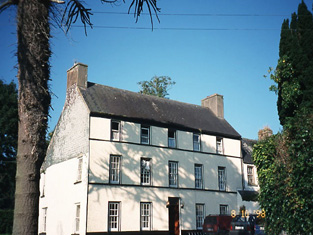
|

